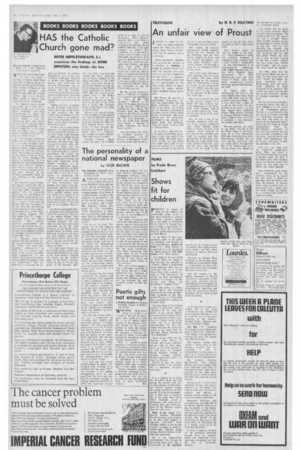Page 6, 7th May 1971
Page 6

Report an error
Noticed an error on this page?If you've noticed an error in this article please click here to report it.
Tags
Share
Related articles
Gallant And Gentle Cinema Critic
Mischievous Debunking By The Master Welles
At The Cinema
FILMS by Freda Bruce Lockhart
Shows fit for children
PARENTS in search of films fit for children are increasingly being driven to
lake their offspring to cinemas far from Leicester Square, from the Mall to Portobello Road. The I.C.A. Young Cinema is doing a real service for escapees from "X" certificates with its week-end programmes at Nash House.
In the latest of these programmes, open to the public on Saturdays and Sundays at 2.30 and 4.30 p.m., Asterix the Gaul ("U", Nash House) is supported. or rather reinforced by. Buster Keaton's The Railrodder ("U", Nash House).
Not being of the age group at which these are aimed, I had not seen the episodes of "Asterix" which I understand most under-tens have seen on television. The art is of the broad blunt style, remotely related to "The Flintstones", of which the most distinguished example I remember in the cinema was Halas and Batchelor's "Animal Farm."
The style makes for rather coarse figures and laboured movements, far from the lightning animation of the bestperiod Disney—as i had lately been reminded by a glance at Donald Duck.
But the colour of the French cartoon is attractive. Asterix. followers of the strip will know, is an ancient Breton empowered by a magic potion to lead patriotic French resistancc to Julius Caesar in his Gallic war. It is admirable entertainment for the very young who may be envied for seeing at the same time the inimitable Buster Keaton in "The Railrodder".
Made in the 1960's for the National Film Board of C'anada, this happy half-hour picture, with the great tragiclown at his most relaxed as he rolls along the Canadian Pacific Railway, waking or sleeping, through prairies, Rockies and Great I.akes is a treat for all ages.
Keaton is also the nicest fellow-traveller 1 can imagine for a singularly attractive travelogue, It is a surprise to go along the Portobello Road and find among the market stalls and bargain antiques the little Electric Cinema, popular among the young and hirsute of that quarter. It is even more surprising to find there a Japanese film in an exotic Inca setting which ironically proves a wholesome relief from the increasing lewd and lurid products of the Western cinema these last few years.
Bride of the Andes ("U," Electric Cinema, Portobello Road) is in many ways as naive as its title might suggest. A Japanese mail-order bride (Sachiko Hidari) is sent by her relatives in Japan to marry a middle-aged widower living among primitive Indians in the Peruvian mountains.
He is an impassioned archaeologist who dreams of excavating Inca ruins. She is fascinated, as the spectator must be, by the foreign ways of the Indians, their oppression by white settlers and the subtle nuances of human difference and kinship.
Directed by Susumu Hani (husband of the leading lady), the film has no particular shape — no beginning, no clear middle, and it often feels as though there may be no end.
But the scenery in the highest mountains of Bolivia and Peru is spectacular in the true sense; tentative human relationships between people at once primitive and sensitive are extraordinarily appealing and in the film achieves a genuine simplicity all too often absent from the cinema.
At the Academy Cinema is a double bill of far more sophisticated and intellectual preoccupation with the arts, as practised by two of the great directors of the cinema: Sweden's Ingniar Bergman and Italy's Frederico Fellini.
The Rite ("X." Academy Two) is the latest in Bergman's series ("The Face", "Persona", "The Shame") of pictures examining the artist, his nature and place in society.
The present strange tale, almost a short story in ten chapters, presents for ex amination a trio of distinguished touring actors arrested in a strange city for an allegedly obscene performance.
The husband (Gunnar 13jornstrand), wife (Ingrid Thulin) and lover (Anders Ek) have exhausted each other in their personal lives. Their interrogation by the judge (Erik Hell) becomes a probe in depth into their own and his deepest motives.
Bergman's constant obsession with sex and religion discovers in the actor's art, with its early roots in medieval mystery and miracle, a religious power verging on the satanic to inspire their ritual.
Bergman's brilliance and concentration, the high skill of his players and for many of us the fascination of his theme, make the film enthralling despite the immobility imposed by its television origin. I can never entirely free myself of the recognition in Bergman of the same streak of charlatanry he is so keenly aware of in his theatrical characters.
It must, I suppose, account for the otherwise surprising descent from his superior moral and intellectual elevations into something very like the dip of permissive fashion.
blog comments powered by Disqus











